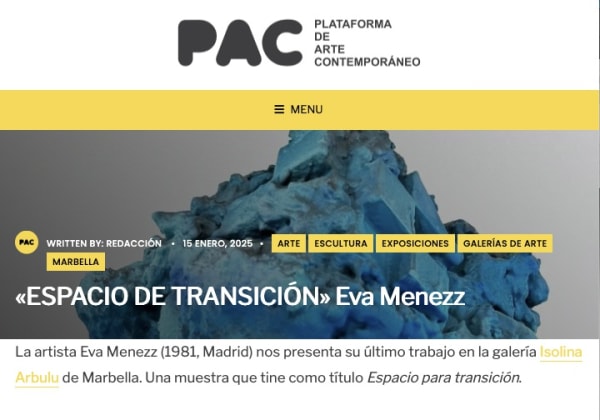Space for transition: Eva Menezz - Black Room
Each block can be compared to a character of a coding system, such as a letter or a binary digit, which, in combination, make it possible to construct a complex and versatile visual language. In this process of visual codification, the blocks vary in size and thickness, forming a topography on the canvas that evokes a miniature landscape, a model of simplification and schematization that invites the eye to move through it.
The materiality of the work, supported by wood, adds a palpable dimension to the colour. This natural material not only adds volume, but also introduces a play of light and shadow that lends subtle nuances to the flat, dense surfaces. The wood appears robust and organic, transforming each block into an element that preserves a connection with nature and the territory.
The assembly of these blocks on the canvas is reminiscent of the assembly of a Meccano, where the concept of play becomes central. This playful arrangement invites the viewer to interact visually, generating an accessible and close experience that eliminates barriers between the public and contemporary art. Menezz seeks a language that is comprehensible and attractive, in which interaction becomes a means of learning and discovery.
Eva Menezz's work moves between figuration and geometric abstraction, with clear influences from Pop Art and Minimalism. Her colour palette is vibrant and direct, employing vivid tones that stand out in the recent series Blocks, Structurals and Interferences. Here, colour not only defines the blocks, but becomes a field of formal experimentation where the artist explores compositional balance and the power of simplification to generate multiple and accessible meanings.
In Space for Transition, Menezz's work invites us on a visual journey, a synthesis of the complex through colour and play, fostering an experience of deep connection that invites visitors to experience art in its purest and most essential forms.
-
 Eva MenezzCaramel Blocks / Cyan Blue, 2024Mixed media, wood and acrylic20 x 22 x 8 cmSeries: Caramel Blocks
Eva MenezzCaramel Blocks / Cyan Blue, 2024Mixed media, wood and acrylic20 x 22 x 8 cmSeries: Caramel Blocks -
 Eva MenezzCaramel Blocks / Purple, 2024Mixed media, wood and acrylic20 x 22 x 8 cmSeries: Caramel Blocks
Eva MenezzCaramel Blocks / Purple, 2024Mixed media, wood and acrylic20 x 22 x 8 cmSeries: Caramel Blocks -
 Eva MenezzEl mapa, interferencias, 2022Acrylic on wood121 x 150 cm
Eva MenezzEl mapa, interferencias, 2022Acrylic on wood121 x 150 cm -
 Eva MenezzMoss wall, 2024Acrylic paint on wood blocks, spray and cement.98 x 95 x 11 cm
Eva MenezzMoss wall, 2024Acrylic paint on wood blocks, spray and cement.98 x 95 x 11 cm -
 Eva MenezzPluto, 2024Mixed media. Wood blocks, cement, plaster, spray paint, polyurethane resin, acrylic paint on MDF structure.35 x 51 x 41 cmSeries: Dwarf Planets
Eva MenezzPluto, 2024Mixed media. Wood blocks, cement, plaster, spray paint, polyurethane resin, acrylic paint on MDF structure.35 x 51 x 41 cmSeries: Dwarf Planets -
 Eva MenezzHaumea, 2024Mixed media. Wood blocks, cement, plaster, spray paint, polyurethane resin, acrylic paint on MDF structure.38 x 39 x 35 cmSeries: Dwarf Planets
Eva MenezzHaumea, 2024Mixed media. Wood blocks, cement, plaster, spray paint, polyurethane resin, acrylic paint on MDF structure.38 x 39 x 35 cmSeries: Dwarf Planets -
 Eva MenezzCeres, 2024Mixed media. Wood blocks, cement, plaster, spray paint, polyurethane resin, acrylic paint on MDF structure.100 x 38 x 17 cmSeries: Dwarf Planets
Eva MenezzCeres, 2024Mixed media. Wood blocks, cement, plaster, spray paint, polyurethane resin, acrylic paint on MDF structure.100 x 38 x 17 cmSeries: Dwarf Planets -
 Eva MenezzBlack fusion, 2024Acrylic paint on wood blocks, spray and cement.83 x 87 x 5 cm
Eva MenezzBlack fusion, 2024Acrylic paint on wood blocks, spray and cement.83 x 87 x 5 cm

























